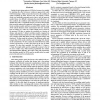Free Online Productivity Tools
i2Speak
i2Symbol
i2OCR
iTex2Img
iWeb2Print
iWeb2Shot
i2Type
iPdf2Split
iPdf2Merge
i2Bopomofo
i2Arabic
i2Style
i2Image
i2PDF
iLatex2Rtf
Sci2ools
114
click to vote
ICCAD
2006
IEEE
2006
IEEE
Analysis and modeling of CD variation for statistical static timing
Statistical static timing analysis (SSTA) has become a key method for analyzing the effect of process variation in aggressively scaled CMOS technologies. Much research has focused on the modeling of spatial correlation in SSTA. However, the vast majority of these works used artificially generated process data to test the proposed models. Hence, it is difficult to determine the actual effectiveness of these methods, the conditions under which they are necessary, and whether they lead to a significant increase in accuracy that warrants their increased runtime and complexity. In this paper, we study 5 different correlation models and their associated SSTA methods using 35420 critical dimension (CD) measurements that were extracted from 23 reticles on 5 wafers in a 130nm CMOS process. Based on the measured CD data, we analyze the correlation as a function of distance and generate 5 distinct correlation models, ranging from simple models which incorporate one or two variation components to...
Related Content
| Added | 16 Mar 2010 |
| Updated | 16 Mar 2010 |
| Type | Conference |
| Year | 2006 |
| Where | ICCAD |
| Authors | Brian Cline, Kaviraj Chopra, David Blaauw, Yu Cao |
Comments (0)

